Text and Photos by Henrylito D. Tacio
Additional photos by AboitizPower
This happened four years ago.
Among those living in barangay Daliao in Toril, Davao City, it was just another day. People were no longer surprised to see marine turtles, locally known as pawikan, being sold in the public market.
“Although local fishermen are very much aware that selling the endangered sea creatures is illegal and prohibited by the government, they are still doing it,” reported Truman Phillip Calipes, who conducted research for his investigative report for a school paper.
A local resident, who refused to be identified, told him: “These fishermen would walk around our purok, selling the pawikans that they caught from one house to another.”
According to her, most of these fishermen caught these marine turtles by accident. When they are pulling out their fishnets out of the water, there are instances where pawikans are included together with the fish. But instead of returning these marine creatures back into the water, the fishermen would just put them in a different barrel and hide them in their fishing boats to elude detection from the local authorities when they arrive at the fish port for inspection.
“The place where they usually catch fishes might probably be a suitable habitat for the pawikans,” the local resident surmised. “Perhaps it is where they swim to after they are released to the ocean from a pawikan sanctuary in a coastal area in the city, which is more or less 10 kilometers from here.”
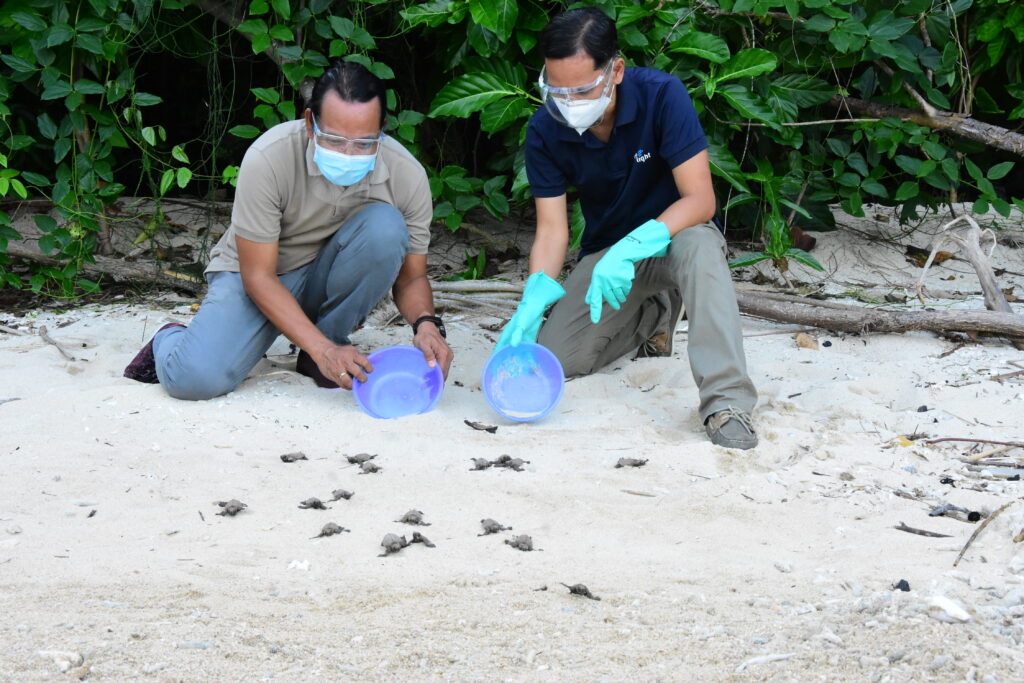
Pawikan released (Photo by AboitizPower) 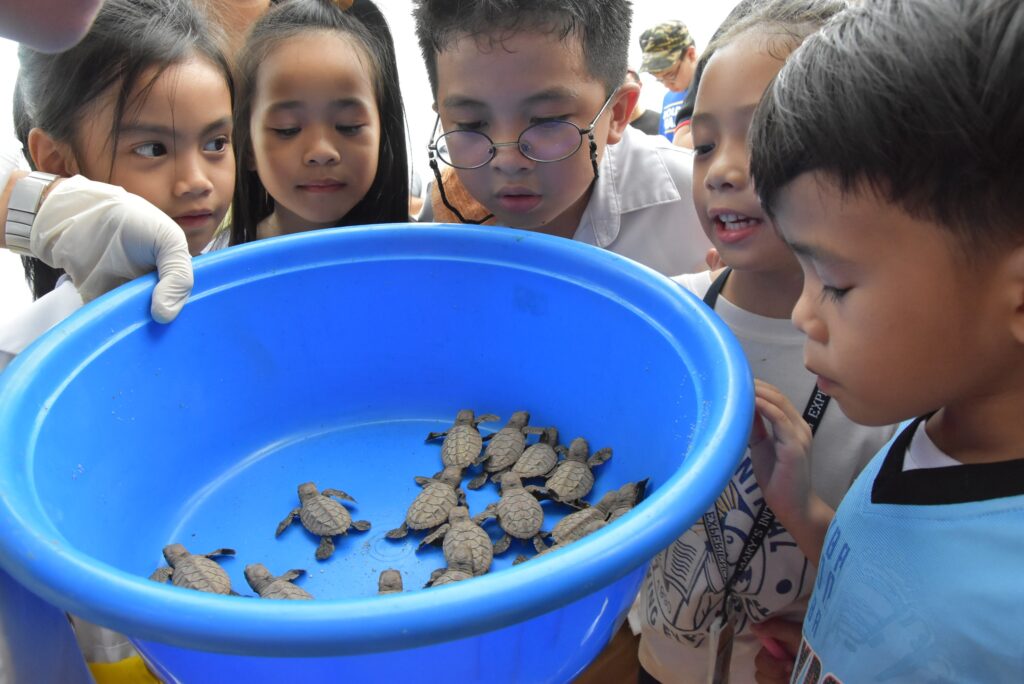
Pawikan hatchlings (Courtesy of AboitizPower)
The woman was referring to the island of Punta Dumalag in Matina Aplaya. The 2-kilometer stretch of the white sand peninsula is part of the 37-hectare Marine Protected Area (MPA) that was established through Council Resolution No. 02504-03. Swimming is not allowed in the area.
The Aboitiz Group, which owns eight hectares in the southeastern portion of the island; the total land area is about 37 hectares. As part of its corporate responsibility, they decided to convert the place into an eight-hectare ecological preserve called Cleanergy Park and managed by Davao Light, an AboitizPower subsidiary.
The park, which is completely wireless and is built entirely using recycled materials, aims to preserve the pawikan nesting grounds and be a home of many thriving bird species. Another objective is to help maintain ecological balance for other sea and land creatures.
Even at night, lights and lamps are not used, except for flashlights of roving guards and staff, in order not to disturb or confuse the pawikans’ nesting in the area and others which considered the park as their home.
Every time there are visitors at the park, Fermin and his team do their part in educating students and guests by hosting tours around the park and allowing visitors to release baby hatchlings into the sea and watch them crawl through the sand and swim into the ocean.
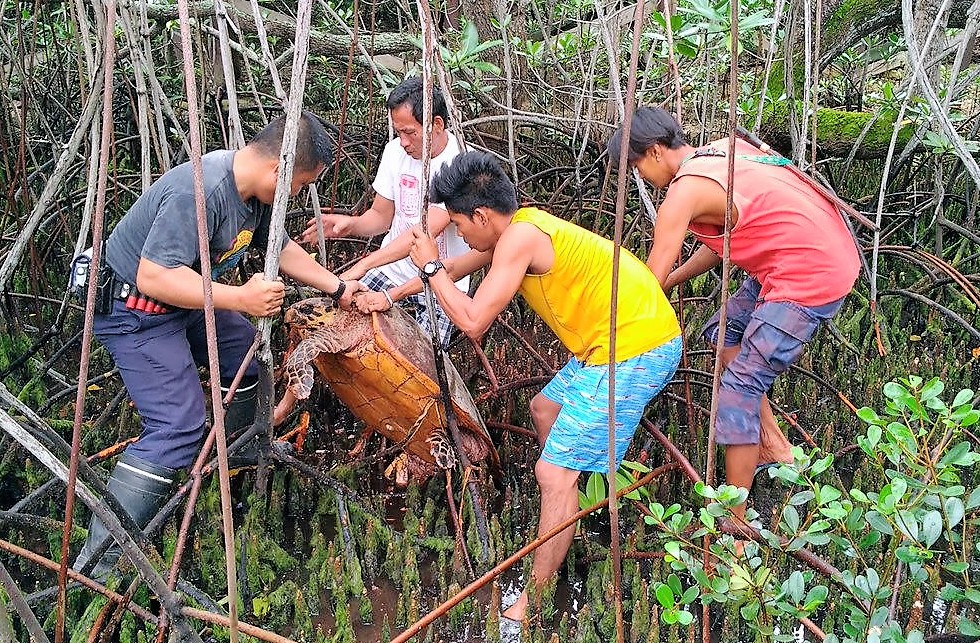
Rescued hawksbill turtle (Photo courtesy of Aboitiz) 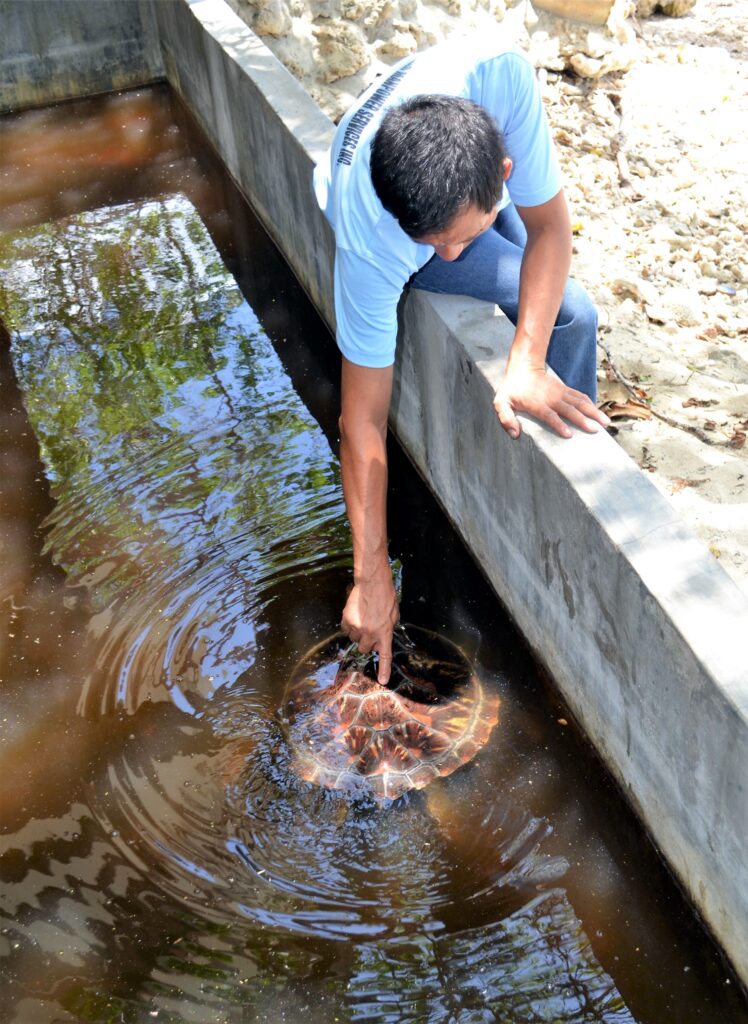
Pawikan recuperating at Punta Dumaglag in Davao City 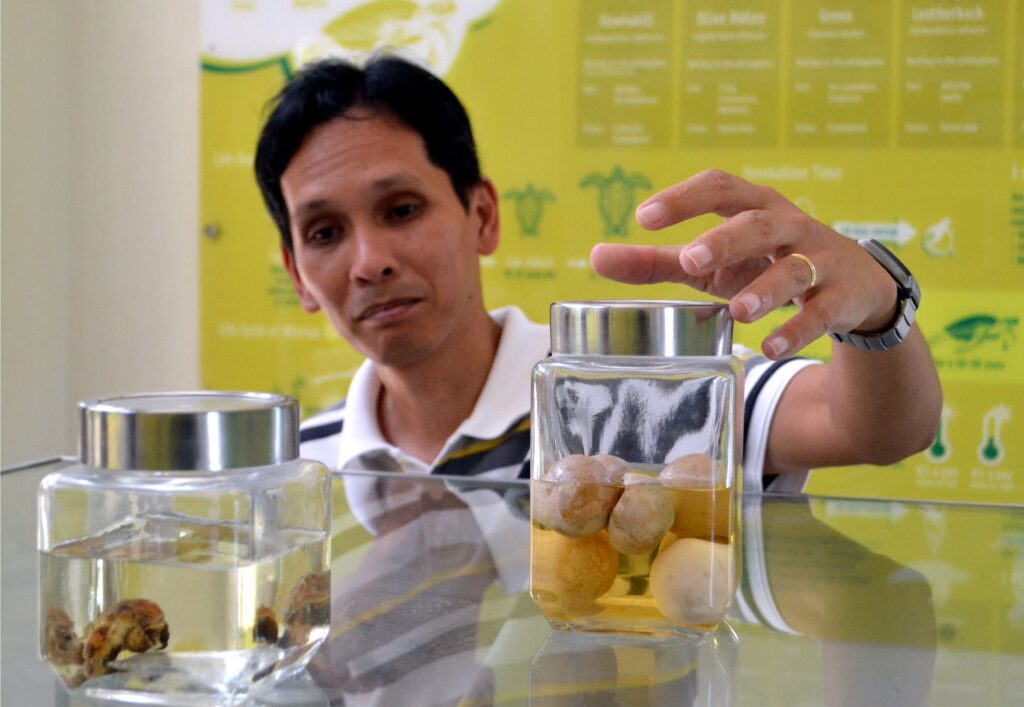
Eggs and fetus of pawikan
“Visitors are taught that it is critical to a pawikan’s early stage of life to grovel through the sand and into the ocean on their own,” the statement said. “The pawikans imprint themselves onto their birthing place, wherein after a few decades, they will return and make their own nests as parents for a new generation of hatchlings.”
Visitors, particularly the younger ones, must know this fact. “It is important to let the youth understand the situation of the pawikans and all other endangered species, so that while they are still young, they are already aware of what they should do and how they could take action to save our wildlife,” said Fermin Edillon, the park’s reputation enhancement manager.
In partnership with the regional office of the Department of Environment and Natural Resources (DENR) and the local government of Davao City, the team at the Aboitiz Cleanergy Park established a Pawikan Rescue Center inside the park as a testament to their commitment to conserve and protect the pawikans and their marine habitat.
This year, a total of 334 newly-hatched sea turtles made their way to the sea from the shoreline of the outdoor biodiversity park. The release of the first batch, with a total of 128 hatchlings, was done on January 20.
On February 5, the park released another batch with 92 baby pawikans. The third batch, with 107 hatchlings, was released eighteen days later. Seven more hatchlings were released on March 6.
All in all, the park released a total of 5,145 hatchlings since it started doing this since 2014.
“We are fully committed to our cause of saving the pawikans,” Edillon said. “We must all carry this responsibility so that our future generations will be able to see them. It can be through small acts such as keeping our coastal areas clean, not littering, and having safe practices when fishing. These are very simple but have a large impact on preserving our environment.”
Marine turtles belong to the order Chelonia, an order of reptiles that have existed and flourished since prehistory with very little change in their basic structure.
Of the eight species of marine turtles known to man, five of them can be found in the Philippines. These are the Green Sea (known in the science world as Chelonia mydas), Hawksbill (Eretmochelys imbricate), Loggerhead (Caretta caretta), Olive Ridley (Lepidochelys olivacea), and Leatherback (Dermocheyls coriacea).
The three others are the Kemp’s Ridley (Lepidochelys kempi), Flatback (Chelonia depressa), and Black Sea (Chelonia agassizi).
Unfortunately, all eight species are listed under Appendix I of the Convention on International Trade of Endangered Species of Wild Fauna and Flora, which means the trade of these species and subspecies is strictly “prohibited except for educational, scientific or research and study purposes.”
The International Union for the Conservation of Nature and Natural Resources has also classified the eight species as endangered. This is so because “their populations are in danger of extinction and whose survival is unlikely if the causal factors continue to operate.”
The Philippines is a signatory of the Convention on International Trade in Endangered Species of Wild Fauna and Flora and implements the Pawikan Conservation Project nationwide through the DENR’s Biodiversity Management Bureau. Since 2001, the hunting, sale, and killing of marine turtles have been banned in the country.
But despite sincere efforts by the government and some environmentalist groups to save marine turtles from extinction, the decimation of the endangered species continues unabated.
“All of the species found in our country are endangered except for the hawksbill which is critically endangered,” said Dr. Arnel “AA” Yaptinchay, founder and director of the Marine Wildlife Watch of the Philippines (MWWP). “The only sure thing is that marine turtle populations are under tremendous threats and if these are not stopped, extinction is imminent.”
The degradation of their habitat has also contributed to the decimation of marine turtles in the country. The ruin of the territories results from increased effluent and contamination from coastal development, construction of marinas, increased boat traffic, and harvest of near-shore marine algae resources.
Marine turtles are also affected by plastics. About 20% – or half a million tons – of the 2.7 million tons of plastic waste the Philippines generates annually leaks into the oceans, according to the 2015 report on plastic pollution by the Ocean Conservancy.
“Plastics endanger marine life and other animals, because they can mistake a piece of plastic for food when it isn’t,” a study pointed out. After eating plastic, they starve and die. Another study, published in the journal Scientific Reports, suggests that ingesting even a single piece of plastic can be deadly for these marine animals.
Six years ago, on October 23, some fishermen found off the coast of barangay 78 in Davao City a dying green sea turtle, which was brought to a non-government organization for treatment. Hours later, it died, and American marine biologist Darrell Blatchley found plastic bags which were extracted from the turtle’s stomach.
A report from the Ocean Conservancy ranked the Philippines third (after China and Indonesia) among the countries with the highest source of plastic ocean pollution, generating 1.88 metric tons of mismanaged plastic garbage annually.
The journal Endangered Species Research also reported that marine turtles “being tangled up in lost fishing nets, plastic twine and nylon fishing line, as well as six-pack rings from canned drinks, plastic packaging straps, plastic balloon string, kite string, plastic packaging and discarded anchor line and seismic cable.”
Dr. Brendan Godley, Professor of Conservation Science at the University of Exeter and leader of the study, commented: “Plastic rubbish in the oceans… is a major threat to marine turtles. We found, based on beach strandings, that more than 1,000 turtles are dying a year after becoming entangled up, but this is almost certainly a gross underestimate. Young turtles and hatchlings are particularly vulnerable to entanglement.”
Marine turtles are also being threatened by climate change. “Potential impacts of global warming, such as projected sea level rise, can lead to shoreline erosion of small, low-lying tropical islands,” MWWP says. “Waves running up the shore during storms will wet the nests and increase egg mortalities at rookeries in these small islands, possibly decreasing the overall reproductive success of the marine turtle population.”
Haribon Foundation for the Conservation of Natural Resources believes so, too. “Unless we, Filipinos, seriously take on the task of protecting the much-endangered marine turtles, these ancient creatures will soon be gone (from our waters),” Haribon, which is regarded as a pioneer of the environmental movement in the Philippines, said in a statement.

